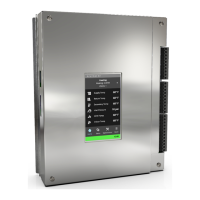BoilerNet Component Requirements
CAN bus interface that
communicates between
boilers.
The wire type and installation must comply with CAN bus standards
such as ISO 11898 and/or SAE J2284.
Cable
Polarity-sensitive twisted 2-wire leads (CAN bus standard) to join
one boiler to the next (to a maximum of 24 boilers). Connection made
between the "Boiler Net" terminals #19 and #20 (see Figure 12 ).
Specifications for the cable:
24 AWG shielded twisted pair
9 twists / ft
Capacitance 12.5pF/ft (cond./cond.)
Resistance 25.5 ohms/1000 ft
Network Wiring Power down all boilers prior to connecting or disconnecting.
The "Boiler Net +" and "Boiler Net –" are polarity sensitive and
must not be crossed.
Network wiring must only be installed in a "Daisy Chain"
arrangement where network wiring goes from the first boiler to
the second to the third to the fourth, and so on.
If using shielded pair wire, ensure the shielding is only
grounded at one end of the "Daisy Chain". If the shielding is
grounded in multiple locations (i.e. at each boiler or at the first
and last boiler,) the shielding becomes ineffective and in some
cases increases the electromagnetic interference affecting
the communication signal.
The termination jumper (JA02) needs to be removed from the boiler
controller boards that are NOT the first or last boiler in the BoilerNet
chain. For example, in a two-boiler network, JA02 must be left
installed in both controls, and in a three-boiler network, the JA02
must be removed on the middle boiler only.
Terminators Terminators must be removed from the middle boilers, and the wire
polarity must be correct at all the boilers.
Table 6 CAN bus setup requirements
3.7.4 BoilerNet two-wire CAN bus daisy chain cabling

